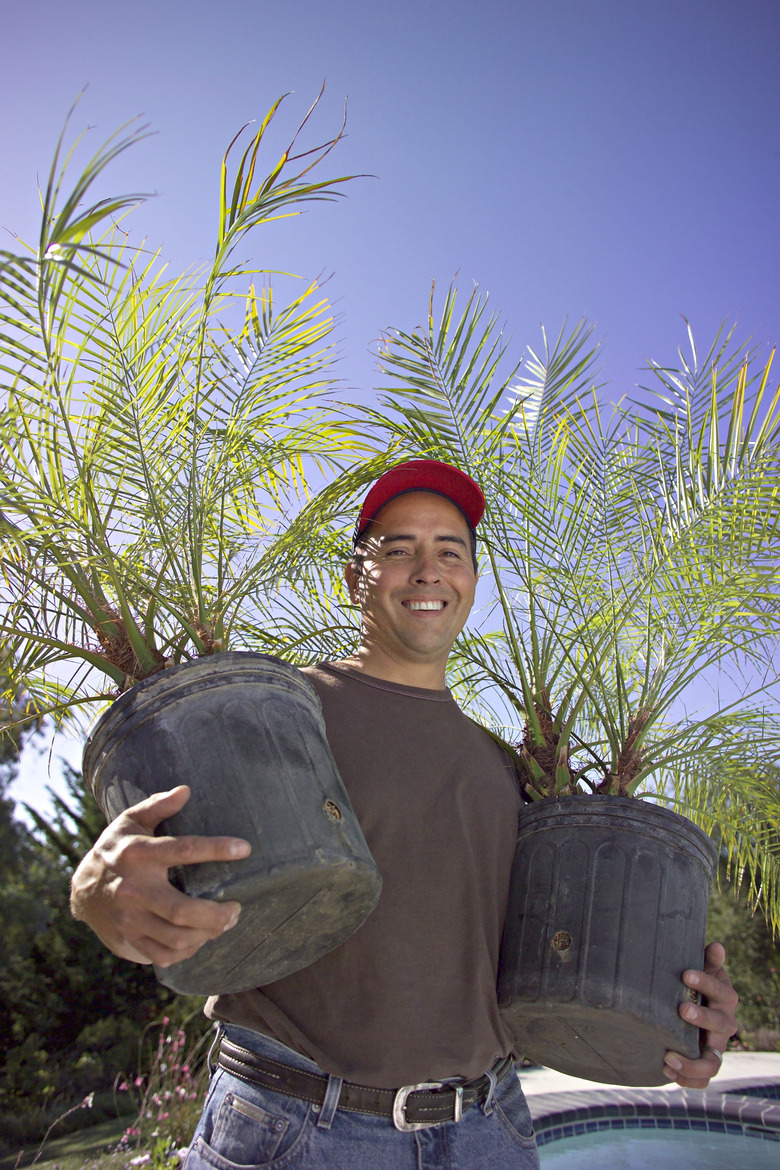Fertilizing Dwarf Date Palms
Palm trees don't have to tower overhead to make an impact, but they do have to be healthy. A pygmy date palm (Phoenix roebelenii) is a graceful single-trunked tree that reaches 8 to 10 feet outdoors in U.S. Department of Agriculture plant hardiness zones 9 through 11, or about 3 feet tall indoors in cooler zones. Whether growing in the ground or potted indoors or out, the right fertilizer helps your pygmy date thrive.
Step 1
Pygmy date palms require specific feeding to stay healthy, and are sensitive — sometimes fatally — to deficiencies in certain nutrients. A healthy pygmy date palm needs to be fertilized three to four times per year with a slow-release, low-phosphorus fertilizer formulated for palm trees that includes additional micronutrients — magnesium, calcium, boron, iron, zinc and copper. An 8-4-8 nitrogen-phosphorus-potassium analysis fertilizer that includes the necessary micronutrients, for instance, would be applied every three months while the palm was actively growing. The rate should be 1/2 cup for every 16 feet of root zone — the area under the canopy of the tree — for a 10-foot palm down to 2 tablespoons of for every 4 feet of root zone for a 2-foot palm. The recommendation for an 8-2-12 fertilizer that includes 4 percent manganese is 1.5 pounds for every 100 feet of canopy. Always follow the specific recommendations on the label of the fertilizer you choose.
Feeding Problem Pygmies
Step 1
Pygmy palms — even those fertilized regularly — can have problems caused by a lack of certain nutrients. Pygmy date palms that don't get enough manganese develop yellow streaks in their new growth and dry, frayed-looking foliage in their upper canopies. Manganese sulfate, better known as Epsom salts, treats the problem — spray it on the foliage as a solution made up of .3 pounds manganese sulfate in 10 gallons of water three to four times a year. A mild boron deficiency can make the tips of pygmy date palm fronds appear hooked with translucent streaks, while a more serious case can make the whole crown of the plant appear to bend in one direction. A soil drench of 2 to 4 ounces of borax in 5 gallons of water can address a mild problem, though University of Florida Extension recommends removing a palm with a noticeably bent crown.
Step 2
- Pygmy date palms require specific feeding to stay healthy, and are sensitive — sometimes fatally — to deficiencies in certain nutrients.
- An 8-4-8 nitrogen-phosphorus-potassium analysis fertilizer that includes the necessary micronutrients, for instance, would be applied every three months while the palm was actively growing.
Applying Fertilizer Properly
Step 1
Because pygmy date palms have narrow trunks, and often have only a narrow band of mulch or soil around them when planted as specimen trees in lawns, gardeners often apply fertilizer too close to the trunk in a concentrated band. Broadcasting fertilizer evenly under the pygmy date palm's entire canopy makes the nutrient boost accessible to the plant's whole root zone, and prevents a high concentration of fertilizer burning the roots in any one place. When your pygmy date palm is surrounded by lawn, keep any grass fertilizers at least 30 feet from the plant. The high nitrogen in these products can cause a palm to produce more green, leafy growth than its available potassium can support. Never apply fertilizer to dry soil, and work the granules gently into the soil with a rake if possible for best results.
Fertilizing Potted Pygmy Dates
Step 1
You need to pay even closer attention to the nutrient needs of container-grown pygmy date palms, since they are usually planted in sterile potting mix. Slow-release fertilizer formulated for palms — again with low phosphorus and added micronutrients — should be applied in spring and again in summer while the plant is actively growing. Recommended amounts are based on the diameter of the planting pot, for instance, 1 1/2 tablespoons of an 8-4-8 palm fertilizer with added micronutrients sprinkled over the surface of a 10-inch diameter pot. A rose fertilizer — these are often amended with the same micronutrients — can fill in for a palm product in a pinch, according to Barbara Pleasant, author of "The Complete Houseplant Survival Manual." Potted pygmy date palms should also get an annual Epsom salts drench to boost magnesium levels. Use 1 teaspoon of magnesium sulfate for every quart of water.
Step 2
- Because pygmy date palms have narrow trunks, and often have only a narrow band of mulch or soil around them when planted as specimen trees in lawns, gardeners often apply fertilizer too close to the trunk in a concentrated band.
- Broadcasting fertilizer evenly under the pygmy date palm's entire canopy makes the nutrient boost accessible to the plant's whole root zone, and prevents a high concentration of fertilizer burning the roots in any one place.
References
- Floridata: Phoenix Roebelinii
- University of Florida Extension: Fertilization Tips for Keeping Palms Green and Healthy
- Vigoro: Vigoro Palm, Ixoro and Ornamental Food
- University of Florida IFAS Extension Lee County: Major Palm Nutrient Deficiency Symptoms and Fertilizer Appliations
- University of Florida IFAS Extension Collier County: Pygmy Date Palms ... Going Anemic — Fatally
- The Complete Houseplant Survival Guide; Barbara Pleasant
